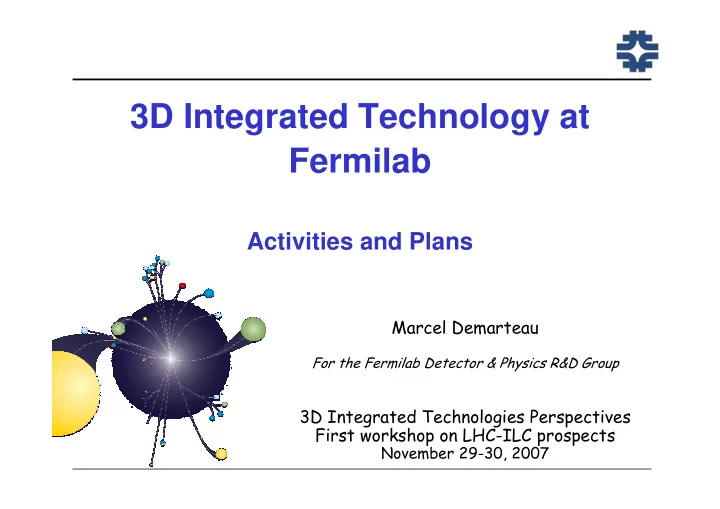

3D Integrated Technology at Fermilab Activities and Plans Marcel�Demarteau For�the�Fermilab�Detector�&�Physics�R&D�Group 3D�Integrated�Technologies�Perspectives First�workshop�on�LHC$ILC�prospects November�29$30,�2007
Fermilab � Located�in�the�western�suburbs�of�Chicago,�Illinois,�on�2750�hectares�site � 1950�employees;�2500�users�of�whom�1000�from�abroad � Currently�highest�energy�machine�in�the�world:�the�Tevatron � Currently�highest�intensity�neutrino�beam�in�the�world � A�world�class�astrophysics�program � Fermilab’ ’s s Scientific�Program Scientific�Program � Fermilab � Energy�Frontier � Neutrino�Frontier�� � Particle�Astrophysics � The�only�US�lab.�solely� devoted�to�particle� physics 3D IT Workshop, Nov. 29-30 -- M. Demarteau Slide 2
Fermilab Organization � Most�of�the�detector�R&D�carried�out�in�the�Particle�Physics�Division � ~150�physicists�associated�with�experiments � 84�employees�in�Mechanical�Department� � ���������������������� � ������������ � 54�employees�in�Electrical�Department� � ����������������� � ������������������������� � R&D�supported�by�user�facilities� � Silicon�Detector�Facility� Silicon Facility � ������������������������� � ���� ������ ���������� � !������"� ����������������� Testbeam ����"��������#���� � Test�Beam�Area� � $����%������� � &������'���� ����(�) � &����'���� ���(�) � � * '���� +,�(�) 3D IT Workshop, Nov. 29-30 -- M. Demarteau Slide 3
Past Projects � ASIC�Designs�for�silicon�strip�and�pixel�detectors,�digital�calorimetry,�trigger� pipeline,�voltage�control�and�generation�and�monitoring� � CDS,�analog�pipelines,�Wilkinson�ADCs,�data�sparsification RMMC Trip-T DCAL FPIX-2 FRIC0 SVX4 � Silicon�Strip�and�Pixel�Detectors 3D IT Workshop, Nov. 29-30 -- M. Demarteau Slide 4
Fermilab Perspective � Our�philosophy:�detector�R&D�that�is�of�high�enough�caliber�will be�applied� in�any�future�experiment � Focus�on�what�we�believe�are�the�most�promising�technologies � Build�on�our�significant�strength�and�strong�expertise�in�engineering�for� silicon�particle�detectors�– both�electrical�and�mechanical � All�detector�R&D�is�carried�out�with�a�long�time�scale�in�mind�and�within� a�broad�context:�ILC,�LHC�upgrade�and�applications�beyond� � Adopt�a�fully�integrated�approach:�sensor�development,�associated� readout,�power�delivery,�mechanical�support,�beam�tests� • Fermilab effort in 3D Integrated Technology � Context�of�our�initial�effort:�ILC�challenge � 3D�and�SOI � SOI�Technology � 3D�Technology � Thinned�sensor�R&D � Laser�Annealing � Power�distribution � Mechanical�Support 3D IT Workshop, Nov. 29-30 -- M. Demarteau Slide 5
ILC Pixel Detector � Pixel�detector�requirements ~199 ms 969 969 � Very�low�mass:�0.1%�X 0 per�layer� µ s µ s (equivalent�of�100� µ µ m�of�Si) µ µ � Low�power�consumption�(~50�W�for� 1�Giga�pixels)� ILC�Beam�structure: � High�resolution�thus�small�pixel�size� Five�trains�of�2625�bunches/sec � Modest�radiation�tolerance�for�ILC�applications Bunch�separation�of�369.2�ns � Combination�of�small�pixels,�short�integration�time,� low�power�required�for�ILC�is�difficult�to�achieve � Small�pixels�tend�to�limit�the�amount�of� circuitry�that�can�be�integrated�in�a�pixel � Small�pixels�also�mean�that�the�power/pixel� must�be�kept�low � The�low�occupancy/pixel/train�(~0.5%)�means�that� a�sparse�scan�architecture�would�be�appealing�if: � Signal/noise�is�high � Enough�electronics�can�be�integrated�on�a�pixel � We�feel�that�the�best�prospects�for�an�optimal�vertex�detector�are�the� vertical�integration�(3D)�and�related�SOI�technologies.�These�offer�the� prospect�of�thin,�densely�integrated,�devices�with�excellent�signal/noise�and� low�power.�3D�also�offers�prospects�for�integration�of�power�management� into�the�pixel�structure. 3D IT Workshop, Nov. 29-30 -- M. Demarteau Slide 6
SOI Detector Concept Advantages � 100%�fill�factor � Large�and�fast�signal � Small�active�volume:�high� soft�error�immunity � Full�diHelectric�isolation:� latchup free SOI Pixel Detector � Low�Junction�Capacitance:� high�speed,�low�power � Bonded�Wafer:�low�resistive�top�layer�+�high�resistive�substrate,�separated� through�a�Buried�OXide (BOX)�layer� � Top�layer:�standard�CMOS�Electronics�(NMOS,�PMOS,�etc.�can�be�used) � Bottom�substrate�layer�forms�detector�volume� � The�diode�implants�are�formed�beneath�the�BOX�and�connected�by�vias � Monolithic�detector,�no�bump�bonds�(lower�cost,�thin�device) � High�density�and�smaller�pixel�size�is�possible � Small�capacitance�of�the�sense�node�(high�gain�V=Q/C) � Industrial�standard�technology�(cost�benefit�and�scalability) 3D IT Workshop, Nov. 29-30 -- M. Demarteau Slide 7
SOI Detector Development � SOI�detector�development�is�being�pursued�by�Fermilab�at�three�different� foundries: � MITHLincoln�Laboratory�through�MultiHProject�Wafer�submission�(DARPA�funded)� � OKI�Electric�Industry�Co.�Ltd.�in�Japan�through�MultiHProject�Wafer�submission�(KEK) � American�Semiconductor�Inc.�(ASI)�in�US,�through�SBIR�phase�I�grant�(Cypress� semiconductor) OKI MITHLL ASI Feature�size� 150 180 180 (nm) 200 150 Wafer�Ø 150�mm 150�mm 200�mm Transistor� Fully Fully Partially�depleted� type dual�gate depleted depleted Buried�Oxide 200�nm 400�nm 200�nm Work� Test�Struct. Test�Struct.� Conceptual�design underway Mambo�I� 3D�chip Simulation Laser�anneal Work� OKI:�Mambo� MITHLL:�3D�Run�II Test�Structures planned� II 3D�Dedicated Sensors� 3D IT Workshop, Nov. 29-30 -- M. Demarteau Slide 8
Pixel Design in OKI Process � MAMBO�Chip:�Monolithic�Active�pixel�Matrix�with�Binary�cOunters � A�wide�dynamic�range�counting�pixel�detector�plus�readout�circuitry,�sensitive�to� 100H400�keV electrons,�high�energy�XHrays,�and�minimum�ionizing�particles,� designed�in�the�OKI�0.15�micron�process � OKI�process�incorporates�diode�formation�by�implantation�through the�BOX � Chip�architecture�(simplified�due�to�design�time�constraint):� amplifier�– shaper�– discriminator�– binary�counter� � Array�size��64x64�pixels,�26 µ µ mx26 µ µ µ µ m� µ µ � Design�submitted�Dec.�15,�’06 � 13�Nm�implant�pitch,�to�minimize�the� � Chip�delivered�June�’07� “back�gate” effect � Characterization�of�test�structures� � ���������&���&�-�� underway� � 350�micron�detector�thickness 26 µ m 13�um see talk by Ray Yarema 3D IT Workshop, Nov. 29-30 -- M. Demarteau Slide 9
Recommend
More recommend